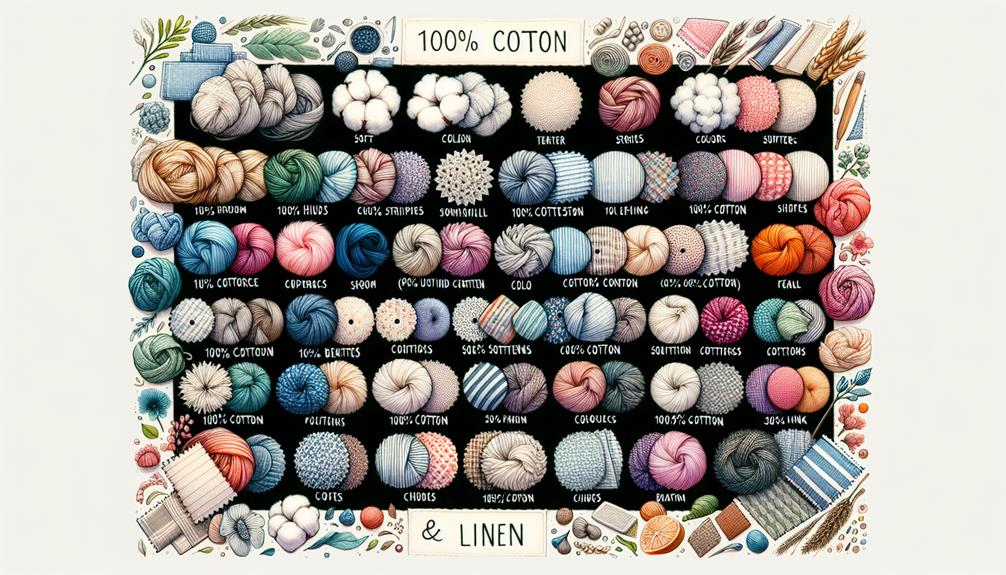I've got you covered! 100% cotton and linen may seem similar, but they have key differences. Cotton is soft and breathable yet wrinkles easily, while linen is absorbent, quick-drying, and wrinkle-resistant. Linen is stronger and better for warm climates, unlike cotton that retains heat. Production-wise, cotton comes from seeds, linen from flax stalks. Linen has a rougher texture but softens over time. If you want to know more about how these fabrics differ and their best uses, read on.
Table of Contents
Key Takeaways
- Cotton and linen are different natural fibers sourced from plants.
- Cotton is softer and wrinkles easily; linen is highly absorbent and wrinkle-resistant.
- Production processes, comfort, durability, and moisture absorption vary between cotton and linen.
- Weave, texture, sustainability, and visual disparities distinguish 100% cotton from linen.
- Choosing between 100% cotton and linen depends on individual preferences and needs.
Cotton Vs Linen Characteristics
When comparing cotton and linen, it's important to understand their distinctive characteristics and qualities that set them apart in the world of fabrics. Cotton and linen are both natural fibers, but they come from different plant sources. Cotton is derived from the cotton plant's seed pods, while linen is made from the flax plant's stalks.
Cotton is known for its softness and breathability, making it a popular choice for comfortable clothing. However, cotton tends to wrinkle easily. On the other hand, linen is highly absorbent, quick-drying, and wrinkle-resistant, making it a favored option for summer apparel. Linen is also renowned for its durability, being the world's strongest natural fiber.
In terms of heat conductivity, cotton is better at retaining heat, making it ideal for cooler weather. Linen, on the other hand, is excellent for warm climates due to its ability to absorb moisture and dry quickly. Understanding these distinctions can help in choosing the right fabric for various purposes.
Production Process Variances
Moving from the discussion of Cotton Vs Linen Characteristics, the production process variances between cotton and linen highlight significant differences in their manufacturing methods and resulting qualities. Cotton is derived from the seeds of the cotton plant, while linen is made from the stalks of the flax plant. The production process for cotton involves harvesting the cotton bolls mechanically, whereas linen requires a laborious process of extracting fibers from flax stalks. Here is a comparison table showcasing the key differences in the production processes of cotton and linen:
| Aspect | Cotton Production | Linen Production |
|---|---|---|
| Material | Derived from the seeds of the cotton plant | Made from the stalks of the flax plant |
| Fibers | Harvested mechanically | Requires manual extraction from flax stalks |
| Thread Count | Starts at around 200 thread count | Not categorized due to thicker threads |
These variations in the production processes influence the characteristics of the final fabrics, with cotton typically having a smoother feel due to its lower thread count, while linen is known for its natural texture and durability.
Comfort and Durability Differences
Linen and cotton differ in comfort and durability due to their distinct fiber origins and inherent qualities. Cotton, derived from the cotton plant, is known for its softness, providing a gentle touch against the skin. On the other hand, linen, sourced from flax plant fibers, has a rougher texture initially but softens over time with washing and proper care.
In terms of durability, linen takes the lead. Its fibers are stronger than cotton, making linen products more resilient and long-lasting. This strength has historically made linen a preferred choice for various applications. Cotton, while soft and breathable, is prone to pilling and wrinkles, affecting its overall longevity.
When it comes to comfort, cotton's softness makes it a cozy option for clothing and bedding. However, linen's exceptional absorbency and quick-drying properties set it apart, making it ideal for items like towels. Both fabrics offer unique comfort and durability benefits, with linen excelling in strength and cotton in initial softness.
Moisture Absorption Variances
When it comes to moisture absorption, linen and cotton behave quite differently.
Linen's ability to absorb moisture quickly and efficiently sets it apart from cotton.
Let's explore how these properties affect the overall comfort and feel of the fabrics.
Cotton Absorbs Moisture
Cotton's moisture absorption capabilities differ from linen due to their distinct structural compositions and natural properties.
Cotton absorbs moisture less efficiently than linen, resulting in a longer drying time. When compared to linen, cotton sheets may feel damp for extended periods due to their lower water absorption rate.
Linen, on the other hand, can rapidly absorb moisture, making it an excellent choice for towels and clothing. Linen's ability to retain up to 20% of its dry weight in moisture showcases its superior moisture retention properties compared to cotton.
This variance in water absorption and moisture retention between linen and cotton highlights the unique qualities each fabric brings to the table, catering to different preferences and needs.
Linens Moisture Properties
With its rapid moisture absorption rate, linen outperforms cotton in keeping you dry and comfortable. Linen's natural properties allow it to absorb water quickly, making it highly absorbent compared to cotton. This means that linen sheets or clothing can effectively wick away moisture from your skin, providing a more comfortable experience.
Additionally, linen can absorb up to 20% of its dry weight in moisture, proving its superior absorbent capabilities. Unlike cotton, linen dries quickly, allowing moisture to evaporate faster. This makes linen an excellent choice for towels and in warm climates where staying dry is essential.
Comparing Moisture Absorption
In comparing moisture absorption, linen's natural fibers and structure allow it to absorb water faster than cotton. Linen's ability to gain up to 20% of its dry weight in moisture showcases its high absorbency levels. This natural fabric efficiently removes perspiration from the skin, enhancing overall comfort.
On the other hand, cotton, while also a natural fiber, takes longer to evaporate moisture and can feel damp for extended periods compared to linen. Due to its quick-drying nature, linen is particularly well-suited for towels and clothing in humid climates.
Understanding these moisture absorption variances between cotton and linen can help in choosing the most suitable fabric for specific needs, whether for bedding, clothing, or other textile products.
Weave and Texture Contrast
Let's talk about how the weave and texture of cotton and linen fabrics differ.
The fiber properties of these materials create a distinct appearance and feel.
While cotton is soft and flexible, linen offers a crisp and durable texture that sets it apart.
Fiber Properties Differ
Exploring the differences in weave and texture between linen and 100% cotton reveals unique characteristics that define their individual properties. Linen, derived from flax, boasts a smoother texture and open weave, setting it apart from the softer cotton with a tighter weave.
Linen's absorbency and quick-drying nature contrast with cotton's breathability and moisture-wicking abilities, showcasing their distinct fiber properties. These variations lead to diverse qualities with regard to durability and comfort. While linen's natural luster catches the eye, cotton's tactile softness appeals to many.
Understanding these fiber variances allows for an appreciation of the specific benefits each material offers, from linen's elegant drape to cotton's cozy embrace. The weave and texture disparities between linen and cotton contribute significantly to their individual charm and functionality.
Appearance Varies Greatly
When comparing linen and 100% cotton, the weave and texture differences create distinct appearances that set them apart visually and tactually. Linen's looser and rougher weave gives it a crisp and textured look, while cotton boasts a smoother texture, offering a softer and more pliable feel.
These fabric characteristics make linen visually unique with its sturdier and rougher feel that softens with time, contrasting with cotton's enduring softness and flexibility. Due to its softer nature, cotton is more prone to pilling, unlike linen, which maintains its durability and crisp appearance.
The weave and texture of each fabric play a significant role in determining their unique qualities, showcasing the visual disparities between 100% cotton and linen.
Feel and Drape Distinct
Feel the difference in your fingertips as you run them over the smooth cotton fabric, contrasting with the textured and sturdy drape of linen.
Cotton textiles are softer due to their fluffy fibers and smoother texture, providing comfort and flexibility. On the other hand, linen fabric, derived from strong flax fibers, boasts a rougher and sturdier texture, resulting in a unique drape that softens over time.
The weave of cotton fabric is tighter, granting it a smoother and more pliable drape, while linen's distinct drape exudes a crisp appearance and durability. Understanding the contrasting drape and texture of cotton and linen textiles can help you choose the fabric that best suits your needs, whether it be for comfort or durability.
Sustainability and Eco-Friendliness Comparison
Comparing the sustainability and eco-friendliness of 100% cotton and linen reveals significant differences in their environmental impact. Linen stands out as the more eco-friendly choice due to its production from flax plants. These plants require fewer pesticides, fertilizers, and water compared to cotton crops, contributing to a lower environmental impact. Additionally, flax plants used for linen grow naturally without the need for irrigation, further enhancing linen's sustainability.
Moreover, linen is biodegradable and recyclable, making it a highly sustainable option compared to cotton. Cotton production, on the other hand, is known to contribute to water pollution and soil degradation, highlighting its higher environmental impact. By choosing linen over cotton, individuals can actively reduce the ecological footprint of textile production and promote more sustainable fashion choices. Embracing linen not only supports eco-friendly practices but also aligns with a conscious effort towards a greener future.
Frequently Asked Questions
Which Is Better Cotton or Linen?
Linen and cotton both have unique qualities. Linen is durable and breathable, ideal for warm weather. Cotton is soft but less sturdy. The choice depends on needs and preferences. I prefer linen for its durability and crispness.
What Fabric Is Similar to Linen?
A fabric similar to linen is cotton. While linen excels in durability and heat conductivity, cotton stands out for its softness and breathability. Both fabrics have unique qualities, making them suitable for different preferences and needs.
What Percentage of Cotton Is in Linen?
I want to clarify that linen does not contain any percentage of cotton. Linen is made from flax plant stalks, distinct from cotton. Understanding this difference is important for anyone looking to differentiate between these two fabrics.
Is Cotton as Breathable as Linen?
Cotton is breathable, but linen excels in airflow and cooling properties due to its natural fibers and loose weave. Linen's superior breathability makes it a top choice for warm climates and summer attire.
- The Best Way to Clean a Suede Fabric Sofa From Oil Stains - July 12, 2025
- Can Suede Fabric Be Dyed Professionally? - July 12, 2025
- What Is Ameri-Suede Fabric? - July 12, 2025




